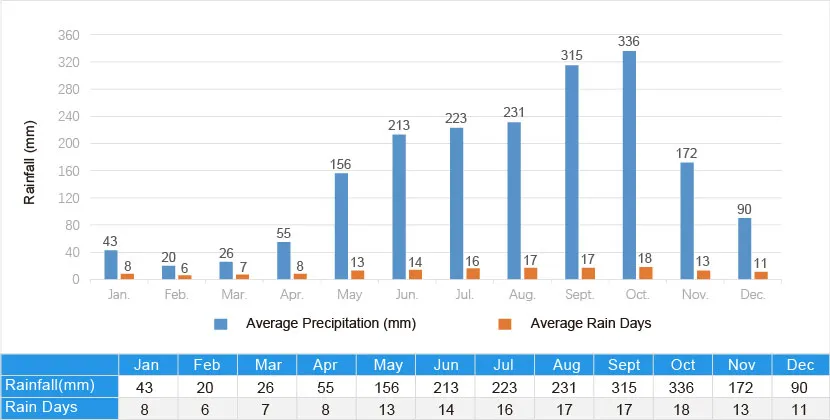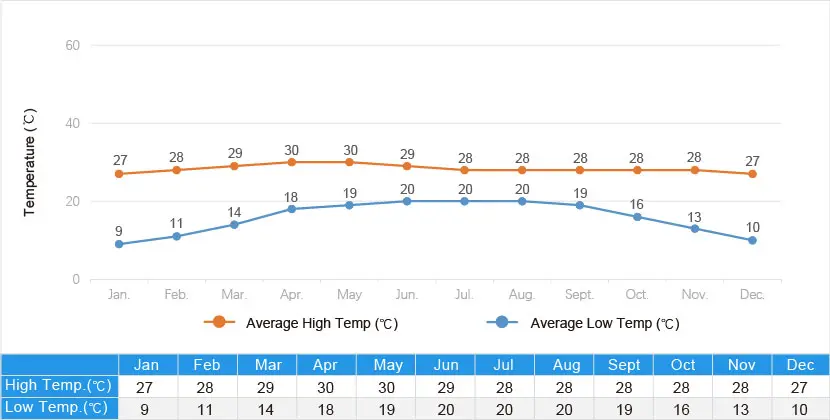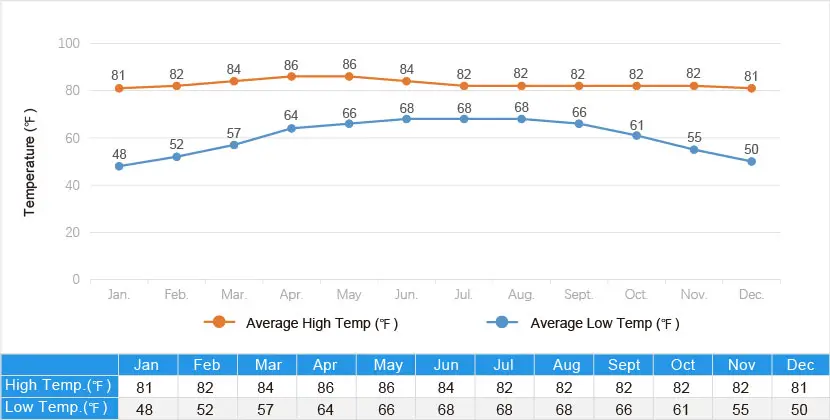Vietnam Weather
Facts of Vietnam Climate & Weather
Lying south to the Tropic of Cancer, Vietnam is warm and humid nearly all year around, with average annual temperature of about 24℃ (75 ℉). Possessing a long and narrow terrain spanning over 1,650 km (1,025 mi) from south to north, Vietnam’s unique geography endows it with different types of climates. The average annual temperature in plains is usually higher than that in mountains and plateaus. Northern Vietnam is cooler with the highest temperature of 37℃ (99 ℉) and the lowest one of 5℃ (41℉). Temperature ranges from 21°C (70℉) to 28°C (82℉) all year round in the south.
Seasonal differences in northern Vietnam are more obvious than in the south. Four distinct seasons can be observed in the north, while most regions of the country are characterized by dry and rainy seasons. The dry season starts from November to April, when monsoons usually blow from the northeast along the coast of China across the Gulf of Tonkin, driving away much of the moisture and bringing a little rainfall. During the rainy season between May and October, the moist air is blown in from the southwest Indian Ocean, bringing abundant rainfall and sometimes even typhoons and storms. The annual rainfall varies from 1,200 mm to 3,000 mm in different regions across Vietnam but mostly happens in the rainy season.
Best Time to Visit Vietnam
However, the best time to visit Vietnam also differs according to your travel destination. If you are a beach lover, then the best time for you to have fun on white sandy beaches are generally from March to August.
| Month | Travel Recommendation | Season | Average Temperature |
|---|---|---|---|
| January | Dry Season | 9-27°C (48-81℉) | |
| February | Dry Season | 11-28°C (52-82℉) | |
| March | Dry Season | 14-29°C (57-84℉) | |
| April | Dry Season | 18-30°C (64-86℉) | |
| May | Rainy Season | 19-30°C (66-86℉) | |
| June | Rainy Season | 20-29°C (68-84℉) | |
| July | Rainy Season | 20-28°C (68-82℉) | |
| August | Rainy Season | 20-28°C (68-82℉) | |
| September | Rainy Season | 19-28°C (66-82℉) | |
| October | Rainy Season | 16-28°C (61-82℉) | |
| November | Dry Season | 13-28°C (55-82℉) | |
| December | Dry Season | 10-27°C (50-81℉) |
 |
Regional Weather of Vietnam
Northern Vietnam – Hanoi, Sapa, Halong Bay
![]() Major Destinations: Hoi An, Da Nang, Hue, Nha Trang, Da Lat…
Major Destinations: Hoi An, Da Nang, Hue, Nha Trang, Da Lat…![]() Weather Review: Central Vietnam’s seasons are quite different from those in the north. Generally, its dry season starts from January to July and the rainy season falls between August and December. There are also occasional typhoons and strong winds happening during the rainy season.
Weather Review: Central Vietnam’s seasons are quite different from those in the north. Generally, its dry season starts from January to July and the rainy season falls between August and December. There are also occasional typhoons and strong winds happening during the rainy season. ![]() Travel Recommendation: Da Nang boasts one of the most beautiful beaches in the world, My Khe Beach, so don’t miss it from April to August. Hoi An preserves more than 800 centuries-old ancient architecture which is worth your lingering. On every month’s Full Moon Festival, the whole town is full of colorful lanterns, creating romantic and cultural atmosphere. Also, Hue has the largest royal palace in Vietnam, and history buffs should pay a visit.
Travel Recommendation: Da Nang boasts one of the most beautiful beaches in the world, My Khe Beach, so don’t miss it from April to August. Hoi An preserves more than 800 centuries-old ancient architecture which is worth your lingering. On every month’s Full Moon Festival, the whole town is full of colorful lanterns, creating romantic and cultural atmosphere. Also, Hue has the largest royal palace in Vietnam, and history buffs should pay a visit. ![]() See more about Hoi An Weather Da Nang Weather
See more about Hoi An Weather Da Nang Weather
Southern Vietnam – Ho Chi Minh City, Mekong Delta, Phu Quoc Island
![]() Major Destinations: Ho Chi Minh City, Mekong Delta, Phu Quoc Island, Con Dao, Mui Ne…
Major Destinations: Ho Chi Minh City, Mekong Delta, Phu Quoc Island, Con Dao, Mui Ne…![]() Weather Review: Southern Vietnam is much warmer than the other two regions. It keeps hot all year around and the temperature is seldom below 20℃ (68℉). The rainy season typically lasts from May to October when there are frequent downpours and storms. Typhoons might land in the south from June to November.
Weather Review: Southern Vietnam is much warmer than the other two regions. It keeps hot all year around and the temperature is seldom below 20℃ (68℉). The rainy season typically lasts from May to October when there are frequent downpours and storms. Typhoons might land in the south from June to November. ![]() Travel Recommendation: As the largest city in Vietnam, Ho Chi Minh City is full of French-style colonial buildings and 21st-century tall skyscrapers, offering both vibrant atmosphere and classic architecture. If you are curious about Mekong Delta’s floating markets, September to November its flooding season, is the best time to visit. If you are island hoppers, then don’t miss Phu Quoc Island and Con Dao, which are considered the best island destinations in the country, boasting white sandy beaches, tropical jungles, coral reefs, and scenic bays. It is perfect to visit islands between November and February.
Travel Recommendation: As the largest city in Vietnam, Ho Chi Minh City is full of French-style colonial buildings and 21st-century tall skyscrapers, offering both vibrant atmosphere and classic architecture. If you are curious about Mekong Delta’s floating markets, September to November its flooding season, is the best time to visit. If you are island hoppers, then don’t miss Phu Quoc Island and Con Dao, which are considered the best island destinations in the country, boasting white sandy beaches, tropical jungles, coral reefs, and scenic bays. It is perfect to visit islands between November and February. ![]() See more about Ho Chi Minh City Weather
See more about Ho Chi Minh City Weather
Typhoon Season in Vietnam
From June to November, the south and central coasts of Vietnam are possibly attacked by typhoons and strong storms. Remember to check the real-time weather forecast if visiting Vietnam during these months.
 C
C
